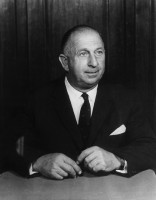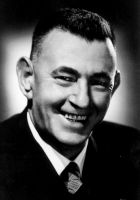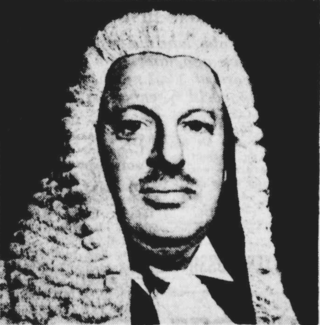
Sir Henry Edward BolteGCMG was an Australian politician who served as the 38th premier of Victoria from 1955 to 1972. He held office as the leader of the Victorian division of the Liberal Party of Australia (LPA) and was a member of the Victorian Legislative Assembly (MLA) for the division of Hampden from 1947 to 1972. He is the longest-serving premier in Victorian state history, having been in office for over 17 consecutive years.
The following lists events that happened during 1982 in Australia.
Ian Macfarlan was the Deputy Leader of the Victorian Liberal Party during 1945. He was briefly commissioned as the 35th Premier of Victoria by the Governor and formed a government which brought about the end of the Dunstan Ministry.

Sir Alexander James Peacock was an Australian politician who served as the 20th Premier of Victoria.
The following lists events that happened during 1947 in Australia.

Sir Albert Arthur Dunstan, KCMG was an Australian politician who served as the 33rd premier of Victoria from 1935 to 1943 and from 1943 to 1945 and as the third deputy premier of Victoria for five days in March 1935. A member of the Country Party, now the National Party, his term as premier was the second-longest in the state's history and the longest of any third-party premier. He was the first person to hold the office of premier in its own right, and not an additional duty taken up by the Treasurer, Attorney-General or Chief Secretary.

Thomas Tuke Hollway was the 36th Premier of Victoria, and the first to be born in the 20th century. He held office from 1947 to 1950, and again for a short period in 1952. He was originally a member and the leader of the United Australia Party (UAP) in Victoria, and was the inaugural leader of the UAP's successor, the Victorian division of the Liberal Party, but split from the Liberals after a dispute over electoral reform issues.

Sir John Gladstone Black McDonald was 37th Premier of Victoria from 27 June 1950 to 17 December 1952, except for a few days in October 1952 when Thomas Hollway led a brief Electoral Reform League government. McDonald came to office by defeating Hollway's Liberals, but was himself vanquished by the Labor Party under John Cain in 1952.
The Court ministry was the 27th ministry of the Government of Western Australia, led by Liberal Premier Sir Charles Court and deputy Des O'Neil. It commenced on 5 June 1975, following the Court–McPharlin Ministry, 15 months after the Coalition's electoral defeat of the Tonkin Labor government. It was followed by the O'Connor Ministry upon Court's retirement as Premier on 25 January 1982.
The McLarty–Watts Ministry was the 21st Ministry of the Government of Western Australia, led by Liberal Premier Sir Ross McLarty and his deputy, Country Party leader Arthur Watts. It succeeded the Wise Ministry on 1 April 1947, following the defeat of the Labor government at the 1947 election two weeks earlier. It was significant in that it included in Florence Cardell-Oliver not only the oldest person, at age 70, to receive their first appointment to a ministerial post in Western Australia, but also the first female cabinet minister in Australia.
The Second Hollway Ministry was the 56th ministry of the Government of Victoria. It was led by the Premier of Victoria, Thomas Hollway and Deputy Premier Alexander Dennett. Hollway and the rest of the ministry were not aligned to a political party at the time, although they would later form the Electoral Reform League to contest the December 1952 election, and had been recently expelled from the parliamentary Liberal and Country Party. With the help of two Hollway supporters in the Victorian Legislative Council, the Labor Party blocked supply to John McDonald's Country Party government, and indicated that they would support Hollway as Premier.

Sir Archie Reuben Louis Michaelis was an Australian politician. He was a member of the Victorian Legislative Assembly from 1932 to 1952, representing the electorate of St Kilda for the United Australia Party and its successor. the Liberal Party.

The 1950 Victorian state election was held in the Australian state of Victoria on Saturday 13 May 1950 to elect 65 members of the state's Legislative Assembly.

Major Sir Thomas Karran Maltby was a politician in Victoria, Australia. He was a member of the Victorian Legislative Assembly for nearly 32 years from 1929 to 1961, served in several ministries and was Speaker of the assembly from 1947 to 1950.
Keith Dodgshun was a politician in Victoria, Australia. He was a member of the Victorian Legislative Assembly for just under 17 years, representing the electorates of Ouyen and Rainbow for the Country Party from 1938 to 1955.
Sir John Herman (Henry) Lienhop was an Australian politician and grazier. He was the member of the Victorian Legislative Council for Bendigo Province from June 1937 to February 1951.
The National Party of Australia – Victoria is a political party in Victoria, which forms the state branch of the federal Nationals. It represents graziers, farmers, miners and rural voters.
Alexander Henry Dennett was an Australian politician.
William Roy Dawnay-Mould was an English-born Australian politician.

The Victorian Liberal Party, officially known as the Liberal Party of Australia (Victorian Division) and branded as Liberal Victoria, is the state division of the Liberal Party of Australia in Victoria. It was formed in 1944. It became the Liberal and Country Party (LCP) in 1949, and simplified its name to the Liberal Party in 1965. The party sits on the centre-right to right-wing of the Australian political spectrum.







